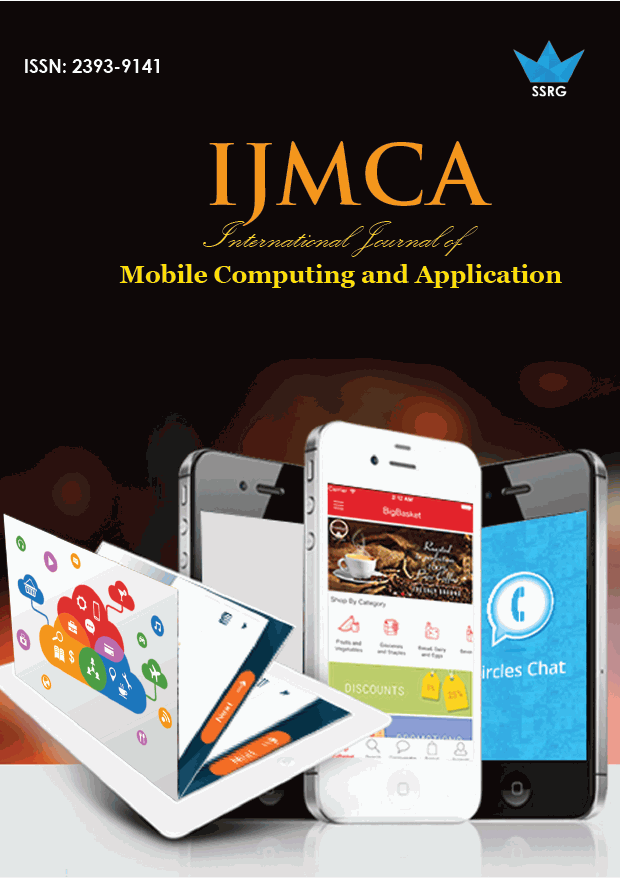A Novel Approach for Mind Control Based Mobile Phone Technology

| International Journal of Mobile Computing and Application |
| © 2014 by SSRG - IJMCA Journal |
| Volume 1 Issue 1 |
| Year of Publication : 2014 |
| Authors : S.Kaniya and Dr.K.Nicholas |
How to Cite?
S.Kaniya and Dr.K.Nicholas, "A Novel Approach for Mind Control Based Mobile Phone Technology," SSRG International Journal of Mobile Computing and Application, vol. 1, no. 1, pp. 1-4, 2014. Crossref, https://doi.org/10.14445/23939141/IJMCA-V1I1P101
Abstract:
This paper discuss about the mind control based mobile phones and now a day’s mobile phones are turned into the UI based interactive device where these are made into touch screen technology in the smart phone system, anyway the system needs the human physical interface to the device but in this paper the interface is given by the mind based controls where the neuron signals are transferred to the mobile phones and it operates what the user thinks in all kinds of cases this has to be discussed detailed process where it is named as neuron phone.
Keywords:
Mind Control, Neuron Phone, User Interface.
References:
[1] Vidal, JJ (1973). "Toward direct brain-computer communication". Annual review of biophysics and bioengineering 2: 157–80.doi:10.1146/annurev.bb.02.060173.001105. PMID 4583653.
[2] Vidal (1977). "Real-Time Detection of Brain Events in EEG". IEEE Proceedings 65 (5): 633–641. doi:10.1109/PROC.1977.10542.
[3] Levine, SP; Huggins, JE; Bement, SL; Kushwaha, RK; Schuh, LA; Rohde, MM; Passaro, EA; Ross, DA; Elisevich, KV (2000). "A direct brain interface based on event-related potentials". IEEE transactions on rehabilitation engineering : a publication of the IEEE Engineering in Medicine and Biology Society 8 (2): 180–5. doi:10.1109/86.847809. PMID 10896180.
[4] NIH Publication No. 11-4798 (1 March 2011). "Cochlear Implants". National Institute on Deafness and Other Communication Disorders.
[5] Miguel Nicolelis et al. (2001) Duke neurobiologist has developed system that allows monkeys to control robot arms via brain signals
[6] Baum, Michele (6 September 2008). "Monkey Uses Brain Power to Feed Itself With Robotic Arm". Pitt Chronicle. Retrieved 2009-07-06.
[7] Fetz, E. E. (1969). "Operant Conditioning of Cortical Unit Activity". Science163 (3870): 955–8. Bibcode:1969Sci...163..955F.doi:10.1126/science.163.3870.955. PMID 4974291.
[8] Schmidt, EM; McIntosh, JS; Durelli, L; Bak, MJ (1978). "Fine control of operantly conditioned firing patterns of cortical neurons". Experimental neurology 61 (2): 349–69. doi:10.1016/0014-4886(78)90252-2.PMID 101388.
[9] Georgopoulos, A.; Lurito, J.; Petrides, M; Schwartz, A.; Massey, J. (1989). "Mental rotation of the neuronal population vector". Science 243 (4888): 234–6. Bibcode:1989Sci...243..234G. doi:10.1126/science.2911737.PMID 2911737.
[10] Lebedev, MA; Nicolelis, MA (2006). "Brain-machine interfaces: past, present and future". Trends in neurosciences 29 (9): 536–46.doi:10.1016/j.tins.2006.07.004. PMID 16859758.
[11] Stanley, GB; Li, FF; Dan, Y (1999). "Reconstruction of natural scenes from ensemble responses in the lateral geniculate nucleus". Journal of Neuroscience 19 (18): 8036–42. PMID 10479703.
[12] Nicolelis, Miguel A. L.; Wessberg, Johan; Stambaugh, Christopher R.; Kralik, Jerald D.; Beck, Pamela D.; Laubach, Mark; Chapin, John K.; Kim, Jung; Biggs, S. James (2000). "Real-time prediction of hand trajectory by ensembles of cortical neurons in primates". Nature 408 (6810): 361–5.doi:10.1038/35042582. PMID 11099043.
[13] Carmena, JM; Lebedev, MA; Crist, RE; O'Doherty, JE; Santucci, DM; Dimitrov, DF; Patil, PG; Henriquez, CS; Nicolelis, MA (2003). "Learning to control a brain-machine interface for reaching and grasping by primates".PLoS Biology 1 (2): E42. doi:10.1371/journal.pbio.0000042. PMC 261882.PMID 14624244.
[14] b Lebedev, M. A.; Carmena, JM; O'Doherty, JE; Zacksenhouse, M; Henriquez, CS; Principe, JC; Nicolelis, MA (2005). "Cortical Ensemble Adaptation to Represent Velocity of an Artificial Actuator Controlled by a Brain-Machine Interface". Journal of Neuroscience 25 (19): 4681–93.doi:10.1523/JNEUROSCI.4088-04.2005. PMID 15888644.
[15] Serruya, MD; Hatsopoulos, NG; Paninski, L; Fellows, MR; Donoghue, JP (2002). "Instant neural control of a movement signal". Nature 416 (6877): 141–2. Bibcode:2002Natur.416..141S. doi:10.1038/416141a.PMID 11894084.
[16] http://www.theguardian.com/technology/2014/jan/10/app-trends-2014-privacy-wearables-education
[17] http://www.technologyreview.com/view/418258/mobile-phone-mind-control/
[18] http://www.scientificamerican.com/article/mind-control-by-cell/
[19] http://computer.howstuffworks.com/brain-computer-interface.htm
[20] http://spark.qualcomm.com/salon/how-mind-controlled-devices-will-change-our-future
[21] Taylor, D. M.; Tillery, SI; Schwartz, AB (2002). "Direct Cortical Control of 3D Neuroprosthetic Devices". Science 296 (5574): 1829–32.Bibcode:2002Sci...296.1829T. doi:10.1126/science.1070291.PMID 12052948.
[22] Pitt team to build on brain-controlled arm, Pittsburgh Tribune Review, 5 September 2006.
[23] Video on YouTube
[24] Velliste, M; Perel, S; Spalding, MC; Whitford, AS; Schwartz, AB (2008)."Cortical control of a prosthetic arm for self-feeding". Nature 453 (7198): 1098–101. Bibcode:2008Natur.453.1098V. doi:10.1038/nature06996.PMID 18509337.
[25] Musallam, S.; Corneil, BD; Greger, B; Scherberger, H; Andersen, RA (2004). "Cognitive Control Signals for Neural Prosthetics". Science 305 (5681): 258–62. Bibcode:2004Sci...305..258M. doi:10.1126/science.1097938.PMID 15247483.

 10.14445/23939141/IJMCA-V1I1P101
10.14445/23939141/IJMCA-V1I1P101